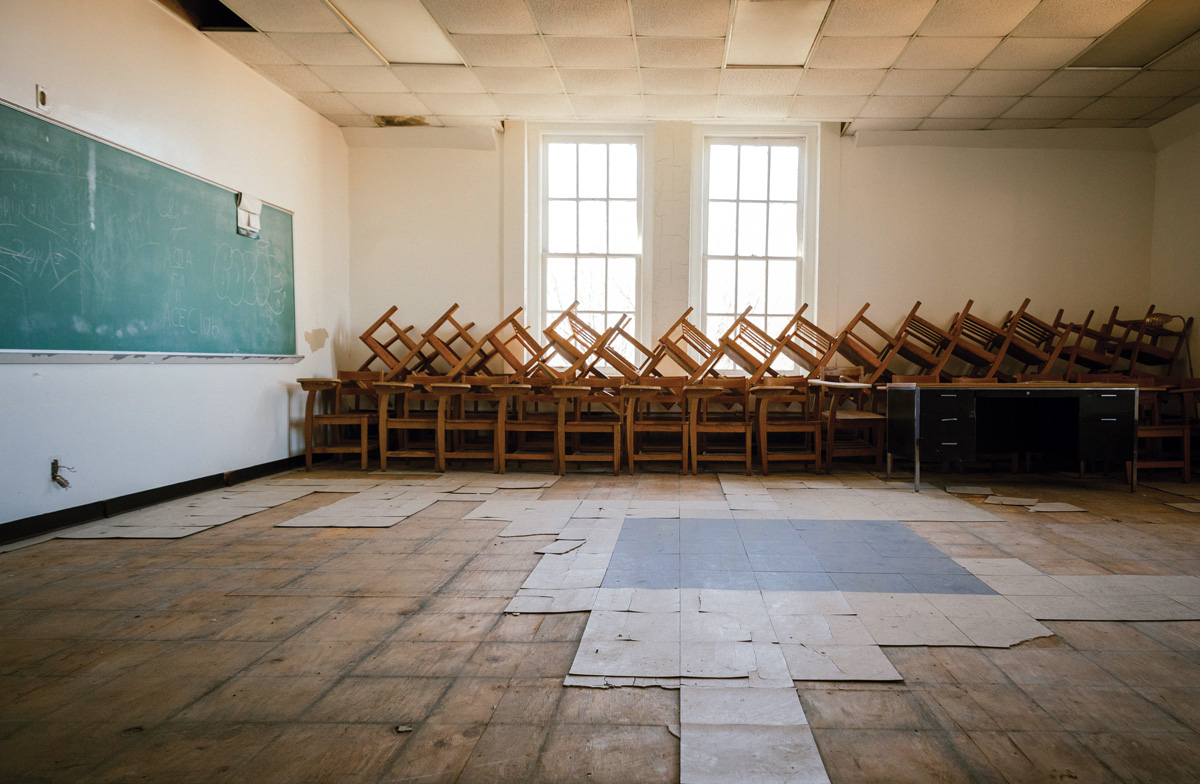
Photograph by Audra Melton
If Derrick Boazman had never gotten lost, he never would have found his way. One day in 1986, the soft-spoken North Fulton High School graduate was taking MARTA to West End to check out Morehouse College, the men’s institution famous for producing generations of black business leaders, artists, and politicians. Boazman accidentally hopped off one stop early at Vine City. He decided to walk.
The path from Vine City station to the Morehouse campus led through the quad of an adjoining college, Morris Brown. Boazman was more than familiar with Morris Brown’s reputation. Its origin story was the stuff of legend—the first institution of higher learning in Georgia for black people, founded by black people. Boazman had a personal connection, too; his mentor, former state Senator Arthur Langford Jr., was a Morris Brown graduate.
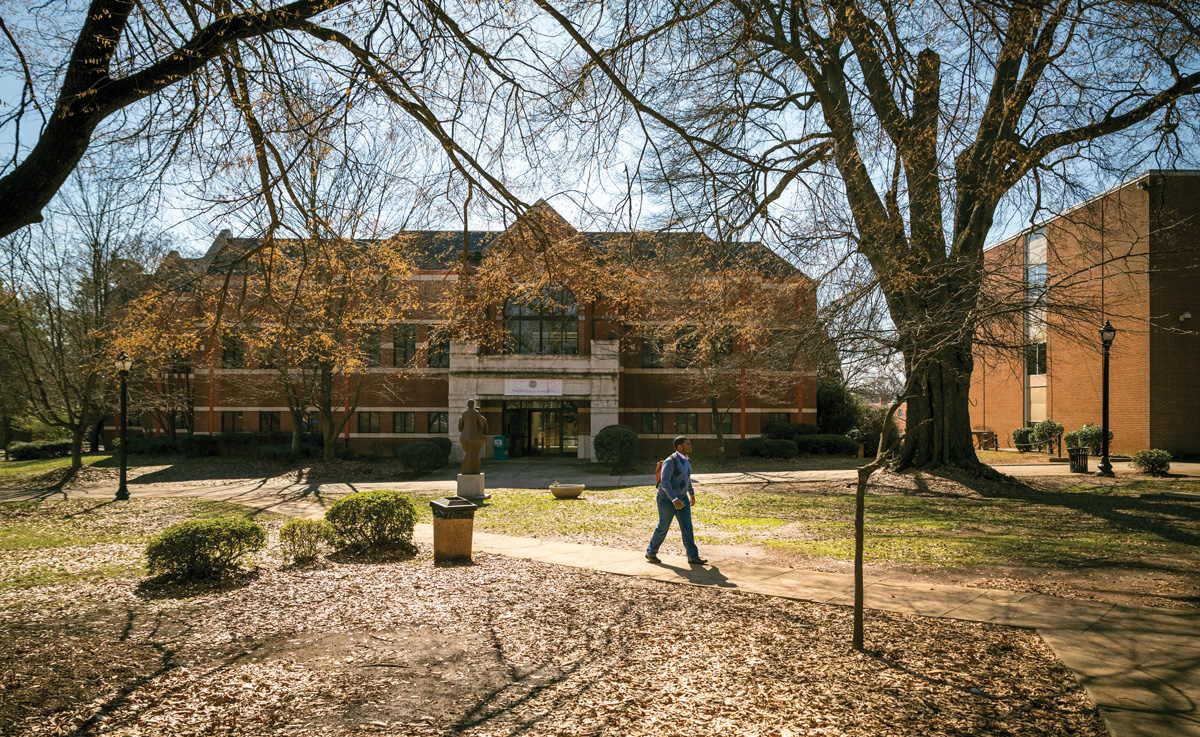
Photograph by Audra Melton
Amid the 40-acre campus that day, Boazman found himself turned around. Tyrone Fletcher, admissions director at the time, asked where the young man was headed. Then he asked about Boazman’s grade point average (a solid 3.5). On the spot, Fletcher offered Boazman a scholarship. Perhaps it was the brazenness of the moment. Maybe it was the history in living color that surrounded him. At that point Boazman forgot about Morehouse.
“That this guy stops and says, ‘This is somebody we want at this school’?” says Boazman. “I’ll never forget the day. By the end of the day, I’m enrolled and registering for courses. Morris Brown chose me.”
The south side native walked into Morris Brown as a quiet kid with a speech impediment. Over the next four years he grew into the man he would become—a rabble-rousing firebrand who was elected student president and led a three-day takeover of a campus building to protest a lack of black studies courses.
These days, “I ride into a radio station where they pay me to talk,” Boazman says of his gig as host of Too Much Truth, a talk show on WAOK-1380 AM. “I learned how to talk at Morris Brown. I learned I had a voice and something to say as a student activist. Every dime I make in my professional life comes as a result of what I learned running my mouth as a college student.”

Photograph by Audra Melton
Boazman became a city councilmember at age 30 and later toured Europe as a German Marshall Fund Fellow. His own success in the years after he graduated stands in stark contrast to the fate of his alma mater, which foundered in the early 2000s. A dozen years ago, massive debt, compounded by embezzlement charges against its then-president, left the school a college in name only. Stripped of its accreditation, neither Morris Brown nor its students could accept federal financial aid. Enrollment, Attendance, once as high as 2,500 students, dropped to just 100; faculty left; and buildings were boarded up as budgets dwindled. The indomitable Marching Wolverines Band, featured on Outkast’s “Morris Brown” and in the 2002 film Drumline, went silent. The only question was whether trustees would pull the plug altogether.
In recent years Morris Brown has taken on the feel of an old battleship gradually being decommissioned, manned by a skeleton crew. But school officials insist that though it’s been down, Morris Brown is far from out—and that a rebirth is close at hand. Faith abounds, but is it enough?

Photograph by Audra Melton
Morris Brown was born from audacity. On a winter’s day in 1881, local African Methodist Episcopal clergy, many of whom had been born into slavery, gathered in Big Bethel AME Church in the Old Fourth Ward. Clark College, a school for black students founded by white Methodist missionaries, needed their help to “furnish a room” on the Clark campus. But the clergy had other ideas; they decided to open their very own college instead.
A three-year fundraising campaign, fueled mostly by contributions from Georgia AME churches, helped raise the $13,000 needed to buy property and build a school named for Morris Brown, an AME bishop who fled to Philadelphia from Charleston in the 1820s after being accused of plotting a slave revolt. Morris Brown opened its doors in the Old Fourth Ward on October 15, 1885, to 107 middle, high school, and college students.
“Morris Brown College was there to provide them an opportunity,” says Henry Porter, a longtime math professor who has forgone a paycheck since 2003 out of love for the school. “If you really wanted to go to school, you could get that opportunity at Morris Brown College. It allowed folks just out of slavery to get an education.”
Unlike Morehouse, Spelman, and other HBCUs operating in Atlanta, which benefited from the financial backing of their white founders, Morris Brown would have to lean on the AME church for support.

Photograph by Audra Melton
In the decades that followed, enrollment would swell. In 1907 the college’s vice president Reverend R.D. Stinson told a New York fundraising crowd the “object of Morris Brown is to reach the boys and girls from the plantations” and to turn them into “good tillers of the soil and homemakers.” Five years later, Morris Brown added graduate courses and opened two satellite campuses, in Cuthbert and Savannah. High school graduates from as far away as Africa flocked to the school.
In 1940, Atlanta University, the onetime home of W.E.B. Du Bois, deeded its former campus and historic buildings for $1 to Morris Brown, allowing the school to cluster with other HBCUs near Vine City and West End. The move kicked off a building boom. In the late 1940s, Herndon Stadium was built on land bequeathed to the college by Alonzo Herndon, the life insurance magnate and Atlanta’s first black millionaire. Students could drink sodas and listen to the jukebox—and potentially steal a dance if the college president was out of sight—at the student co-op in Thurber Cottage.
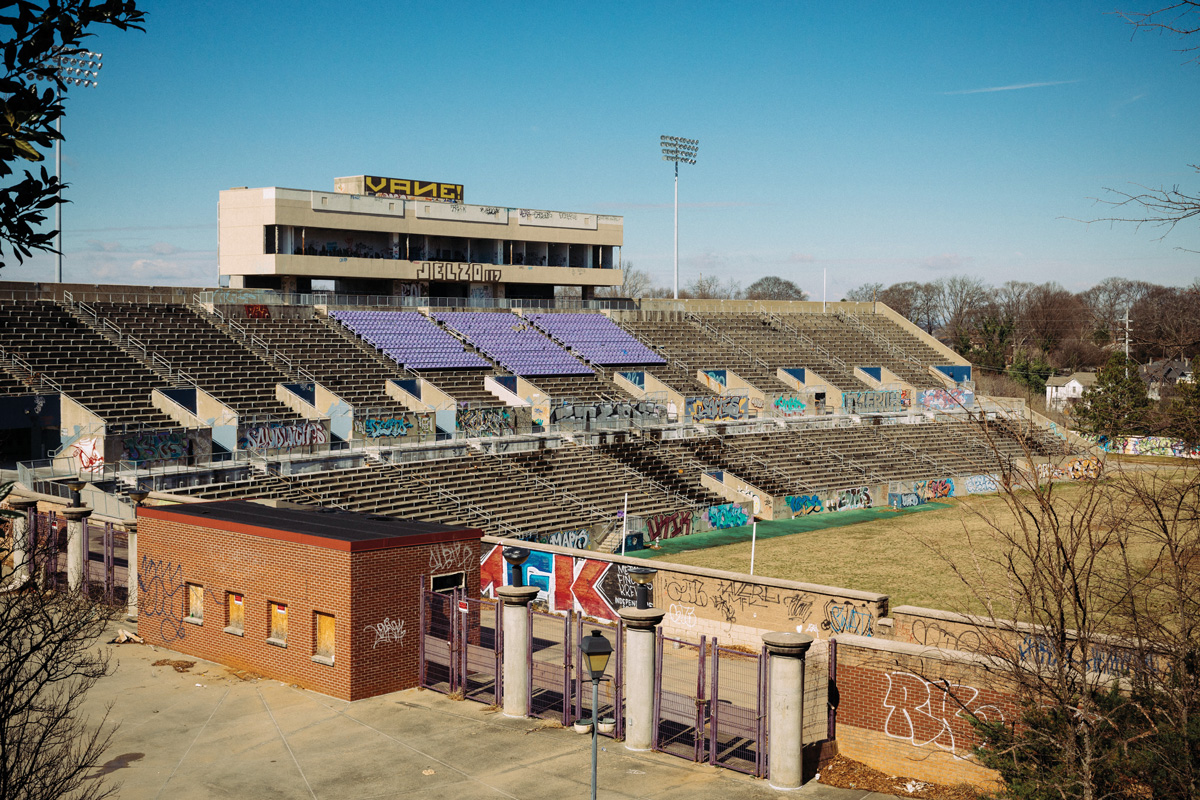
Photograph by Audra Melton
The school began offering degrees in nursing, chemistry, and business management. It built a student union, twin dorm towers, and labs. Morris Brown produced a Rhodes scholar; was three times named the nation’s best black college football team; and graduated future Pulitzer winners, civil rights leaders, and NFL stars. Its nationally known marching band attracted just as many people to Herndon Stadium, which hosted the 1996 Olympics field hockey competition, for halftime shows as did the football team itself.
Students were required to study the college’s history, connecting them with the humble yet radical beginnings of their institution. Professors were tough on students, calling them if they missed classes, says Charles F. Barlow Sr., a 1971 graduate who credits Morris Brown for helping him go from sharecropper to Xerox executive.
“We were always considered the underdog,” says Barlow, a past president of the school’s national alumni association, whose four children all attended the college. “People would put us down because we weren’t prestigious. That gave us extra determination to beat them in athletics and academics.”
That dynamic repeated itself year after year, creating a network of thousands of Brownites that returns every year for homecoming to reunite, reminisce, and occasionally shed a tear for the school that was. “At the end of the day, what we saw on the campus was family,” Boazman says. “These were our homes away from home. That’s why there’s this longing and calling you can’t get away from.”
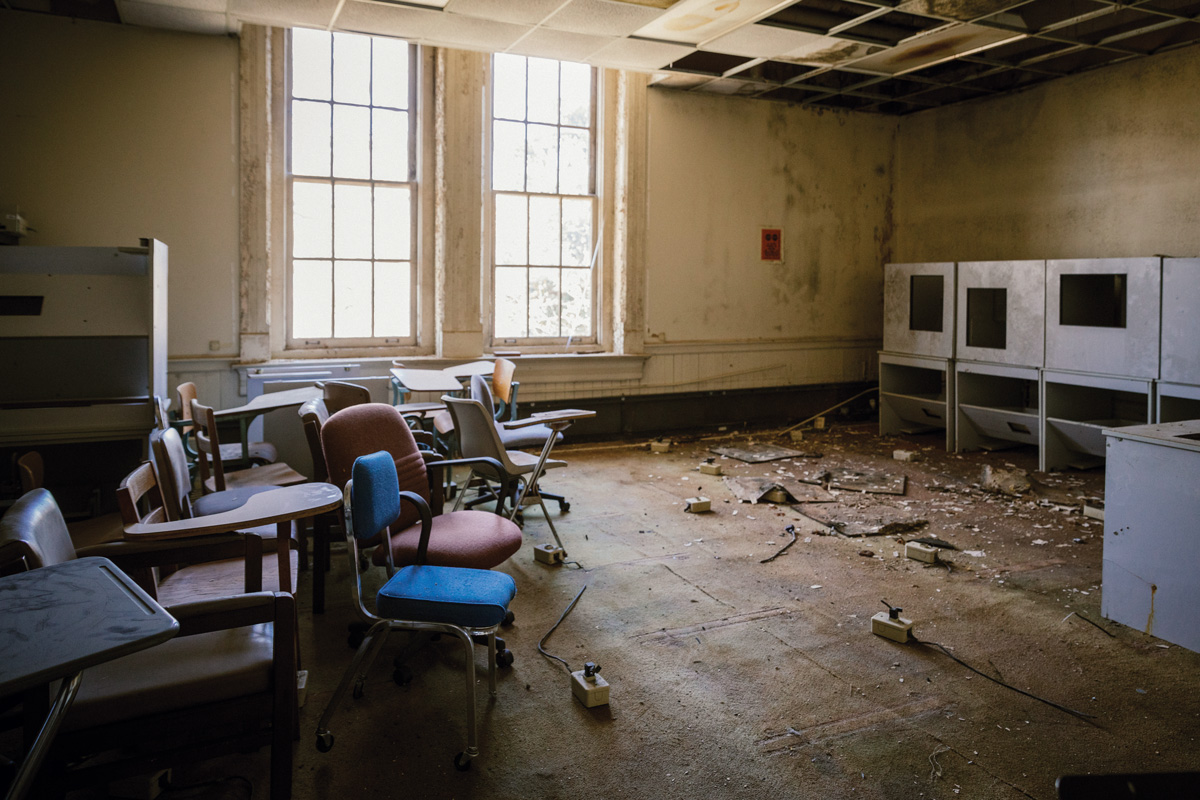
Photograph by Audra Melton
As Morris Brown’s ambitions grew, so did financial pressures. At one point, debts forced the college to drop its graduate program, close satellite campuses, and enter involuntary bankruptcy. In the 1990s, shortly after Boazman graduated, the board of trustees was staring down a $7 million debt.
Morris Brown hit a low point in 2002, when the Southern Association of Colleges and Schools revoked its accreditation over financial mismanagement. Two years later the then-president and her financial aid director were indicted for puffing up enrollment numbers to fraudulently obtain student loans and using that cash to keep the school in the black.
Losing accreditation meant students could not receive federal financial aid or United Negro College Fund scholarships. At a school where more than 90 percent of students depended on some sort of financial assistance, the effect was devastating. Within six months in 2003, enrollment went from 1,800 students to 100. As tuition revenue evaporated, Morris Brown’s budget fell in one year from $28 million to $3 million. Fountain Hall, an imposing brick building where Du Bois once had an office, was closed. Professors and administrators found new jobs elsewhere. Morris Brown also lost its AUC membership, losing a support network and an opportunity for students to take classes on other campuses. Radio host Tom Joyner donated $1 million and even offered to buy the college, and the UNCF donated $1.5 million. Thanks to outside help, Morris Brown held on—but only by a thread.

a Morris Brown graduate.
Photograph by Audra Melton
Brown sought outside help and found it in Stanley Pritchett Sr., who came on as a consultant. Pritchett had just retired as deputy superintendent of the DeKalb County school district, where two classrooms could accommodate Morris Brown’s entire student body at the time. An Atlanta native, Pritchett hadn’t graduated from Morris Brown, but his late brother, Walter, had. Pritchett began seeing his efforts to keep the school alive as a tribute to Walter. In 2010 Pritchett was named president, but there was no honeymoon period. The school was $28 million in debt. One of his first challenges was to fend off the foreclosure of several properties.
With the blessing of the board of trustees, he began contacting creditors to restructure or resolve debt—and to identify potential partners to help renovate campus buildings. In 2012, the school filed for Chapter 11 bankruptcy protection, which allowed it to erase $30 million in debt by the time it emerged two years later.
The U.S. Department of Education forgave $9.5 million the school owed in exchange for a $500,000 payment. What Pritchett calls a painful decision to sell buildings (Invest Atlanta, the city’s economic development agency controversially purchased Gaines Hall and the stadium in 2014) helped shore up finances. Donors no longer had to feel they were throwing money into a “black hole,” he says, and the trustees board became stronger.

Photograph by Audra Melton
Today, support from the AME church, alumni, plus some foundations, provides the lion’s share of the roughly $3 million annual budget. The school graduates between 14 and 20 students each year, half of whom go on to graduate school. Morris Brown still receives 2,000 annual applications but, Pritchett says, interest wanes when applicants learn financial aid is not an option. Morris Brown has also struck deals for its students to take classes at Georgia Piedmont Technical College and use the library at Atlanta Metropolitan State College. The Centers for Disease Control and Prevention last year gave the college a three-year $900,000 grant to help combat the rise of new HIV infections in black communities.
“We’ve been able to show that even under these difficult circumstances, we have very strong programs,” Pritchett says. “Seeing that light at the end of the tunnel gives you hope.”
Morris Brown undergrads today come to class carrying books and laptops—and a lot of faith. The entire student body numbers just 40, and classes are held in the administrative building. Joseph Parker, a freshman from New York, lives in a dorm room at the Turner Theological Seminary, leased by Morris Brown.
When he’s not in class or hanging out on the quad, he and his friends might head to Clark Atlanta’s campus to mingle. Morris Brown has no dining hall, so Parker either eats lunch in his room or grabs some fast food.
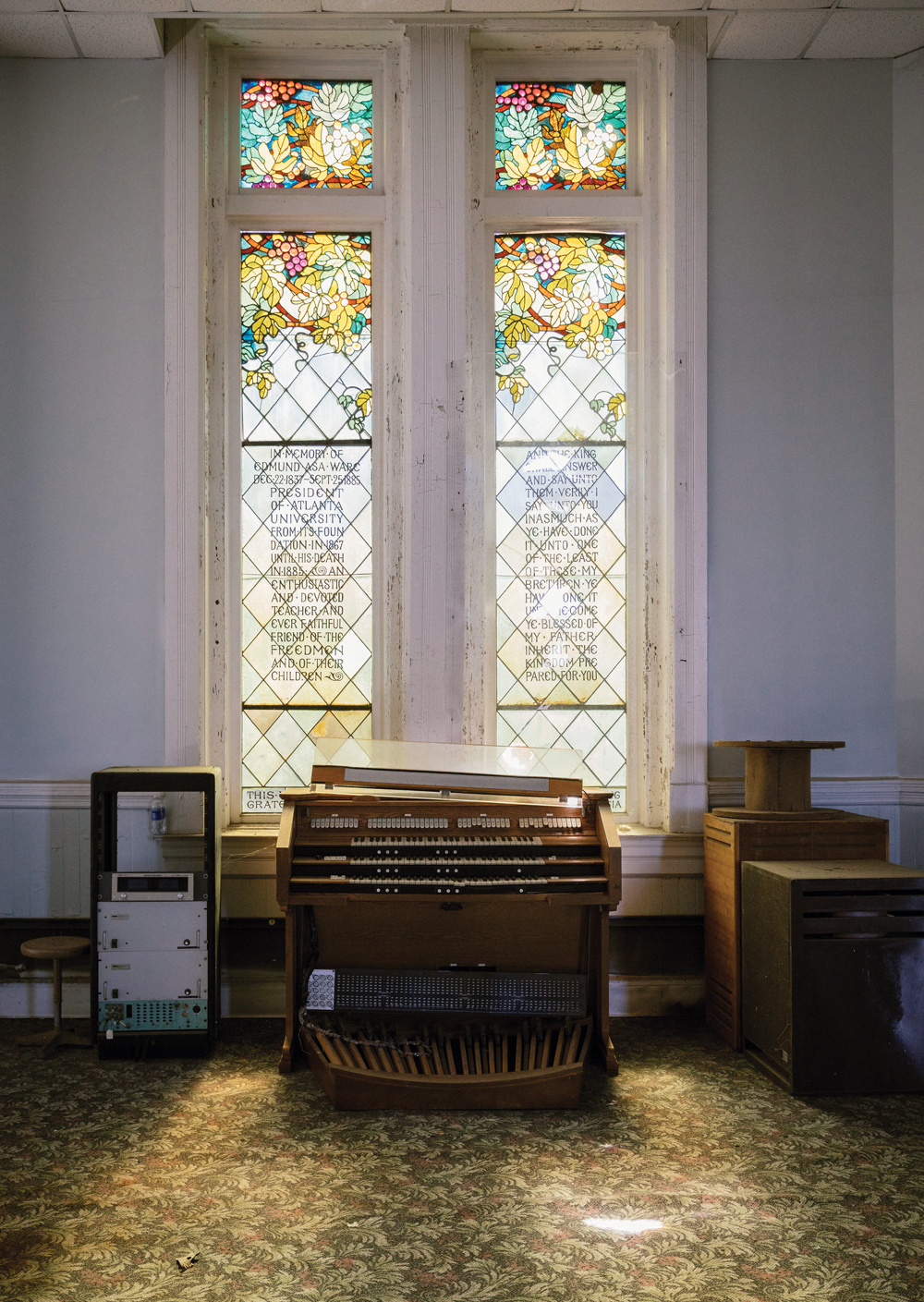
Photograph by Audra Melton
Sometimes Parker longs for the cliched and comforting trappings of a traditional campus. “But I know that’s coming,” he says. “And it’s coming sooner than we think.”
By the end of this month, Morris Brown expects to deliver to SACS a nearly 400-page reaccreditation plan, which will argue that Morris Brown is financially, academically, and physically able to provide a quality education and operate a sustainable university. Urban design firm Perkins and Will, working pro bono, has recommended that Morris Brown reconfigure the administration building, lease nearby buildings, and renovate and lease back the Invest Atlanta properties as enrollment increases. A preliminary SACS ruling is expected next year.
School officials say alumni giving needs to increase to help achieve accreditation. Reverend Reginald Jackson, the chairman of the college’s board of trustees, says former students currently donate roughly $500,000 a year to the school—approximately one-fourth of what Jackson considers sufficient to provide financial stability. If accreditation is obtained and alumni giving increases, the college would have the momentum to launch a 10-year, $100 million fundraising campaign to help restore the historic buildings and buy equipment to ramp up new programs such as tourism and hospitality, STEM courses, film production training, and culinary arts education—essentially creating Morris Brown 2.0. The school and board are also considering additional programs to help veterans.
But going from 40 students to a bustling student body of 1,500 is a marathon, not a sprint. Marybeth Gasman is a University of Pennsylvania professor who’s studied HBCUs. In 2013 she suggested that Morris Brown become a two-year feeder college to other AUC institutions—or even a STEM academy. She says Pritchett was open to the idea but the alumni and staff pushed back. The only HBCU that might be a model for Morris Brown’s recovery is Paul Quinn College in Texas, where the president cut the football program, turned the stadium into an urban farm, demolished 15 buildings, and emphasized experiential learning. Gasman says Morris Brown must be open to change if it’s to recover.
“The old Morris Brown College, there’s no such thing,” says Sharon J. Willis, a composer, performer, and former Clark Atlanta professor who joined the faculty in 2016 to relaunch the music department. “If you can get some of that, fine. But you shouldn’t want all of that. You should want some new things.”

Photograph by Audra Melton
Nearly 30 years after Boazman walked his way into a college that he credits with changing his life, Brian Roberts did the same. In August 2015 the Lithonia native had recently left Florida A&M University, a top 10 HBCU, and decided to visit the school, a place he’d heard had closed.
He made his way past Herndon Stadium, now pockmarked with graffiti, past Gaines Hall, now ravaged by fire. But after meeting admissions officials, he signed on to transfer. Since arriving he’s discovered black composers he never knew lived; learned the ins and outs of music publishing from Willis, his professor; and made connections with Morris Brown alumni in other cities who want to help. On some mornings he practices his clarinet in the dark doorway of Fountain Hall or from a sun-covered bench facing Mercedes-Benz Stadium. To his back is the quiet quad where he hopes to perform Stephen Foster’s “Beautiful Dreamer” at his senior recital this month.
“I believe in Morris Brown,” says Roberts, who takes the bus from Henry County every Thursday to attend classes. “To see it on the verge of decaying, I was like, ‘Why not do this, why not give your time, why not give your service, why not be a student at Morris Brown College?’”
This article originally appeared in our April 2017 issue.














